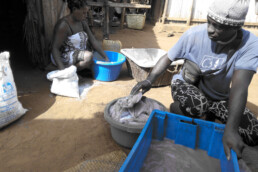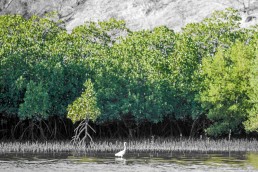IUCN BIOPAMA 
Strengthening the co-management of Nosy Hara Marine National Park
Our partners include:
- Madagascar National Parks
- Ministry of Fisheries
- Blue Economy
Our project with IUCN BIOPAMA strengthens the co-management of Nosy Hara Marine National Park to ensure sustainable management of marine resources and increase the resilience of local communities to climate change.
Implemented in Nosy Hara National Marine Park in the Diana Region of Madagascar, our project runs from January 2023 to June 2024.
We address the following BIOPAMA AC objectives:
- Enhance the management and governance of priority areas by addressing existing limitations;
- Enforce the legal framework required to achieve effective biodiversity conservation in protected areas;
- Support local communities’ initiatives aiming to enhance the livelihoods of local people whilst effectively contributing to protected areas’ management
We also address the following priority needs:
- Lack of surveillance against illegal mangrove harvesting
- Lack of habitat restoration activities (mangroves)
- Illegal catch of octopus and crab leading to a decrease of 20% in annual yield since 2018 – this situation is urgent, especially in specific communities. The basis of concern for management is a knowledge of life cycles, ecology, threats and sustainable harvesting techniques as well as abiding by closed periods, and maximising the yields and profits through improvements in harvest, handling, storage and transport for sale.
- Lack of public outreach and education about the park, the marine systems and regulations much has been done on the level of individual villages, but this will be the first time all 21 villages are impacted as well as news disseminated nationally and internationally via traditional media (radio, film) and social media (website, Facebook, Twitter, BIOPAMA portal).
- Lack of monitoring and surveillance equipment for CLPs
One of the key drivers for the first two problems, is the immigrant fishers from the Nosy Be region coming to exploit Park resources illegally compounded by the limited capacity of CLPs for surveillance and enforcement. This project will ensure wide scale registration of legal fishers with issuance of identification cards to ensure that enforcement is facilitated.
Currently the CLP representatives on the CBO do not even have a list of current CLP members in their own communities. It is therefore urgent to set up a simple and effective database system that is sustainable and transparent.
-
- Type of priority area:
-
- Marine Protected Area
- Marine Managed areas
- Key Biodiversity Area
-
- Primary objective:
- Governance
- Management Effectiveness
- Livelihoods
- Primary objective:
-
- Target groups:
- Local communities
- Youth
- Women
- Farmers/Fishermen
- Target groups:
-
- Main activity focus:
- Sustainable development
- Ecosystem/habitat restoration
- Capacity building
- Main activity focus:
- Awareness/education:
- Monitoring/Patrol equipment
These are the outcomes of our project with IUCN BIOPAMA.
Outcome 1 :
- Increased management effectiveness of Park through capacity building of CLPs and MNP rangers
- There will be 300 active and capable members of CLP across the 21 Park villages, including 23% women.
- CBO capacity built for project management and independent financial management and reporting.
- A capable CLP team, 10 per village, aware of basics of marine ecology, threats, conservation and monitoring.
Outcome 2:
- Increased awareness of Park laws and regulations within and outside the Park to increase compliance
- 6,000+ people aware of the Park and its values and regulations
- Public awareness increases by 50% about the importance of marine biodiversity to human health and wellbeing
- 80%+ of fishers legally registered in a transparent and easily updated database held by Direction of Fisheries
- Up to 2,500 fisher registration cards issued
Outcome 3:
- Degraded marine habitats restored
- 25% of Park communities restore 10 hectares of degraded mangrove forest
- 150 people (>60% women) including youth have a detailed understanding about mangrove forest ecology, threats, values, conservation and monitoring
Outcome 4:
- Community livelihoods enhanced by promoting sustainable octopus fishery
- First VCA completed for octopus fisheries at two pilot sites in the Park
- Octopus fishery improvement plans vetted
- Technical support and materials to improve octopus fisheries
- 10% increase in income from a sustainable octopus fishery
The project implementation creates the following changes for the protected area:
The project aims to enhance management effectiveness of regionally critical marine habitats and biodiversity (mangrove, seagrass, reefs, dugongs, turtles, birds and fish) through capacity building of CLPs in marine ecology, threats and monitoring and surveillance. Wide scale public outreach, registration of CLPs (notably increasing women’s participation in MPA management) and registration of legitimate fishers will ensure higher compliance with Park rules and regulations and easier processes for eliminating illegal and unregulated fishing. Active restoration of mangrove forests by communities and improvements in their income from octopus’ fisheries will improve their overall wellbeing and sustained motivation in MPA management.
Related Case Studies
Contact
C3 MadagascarLot II PA 12 Bis, Soavinimerina, Ambohimanga Rova, Antananarivo, Avaradrano
C3 Madagascar (CONSERVATION CENTREE SUR LA COMMUNAUTE C3 MADAGASCAR), in accordance with Article No. 5 of Ordinance No. 60133, is registered as a non-profit organization in Madagascar under the Direction of the Territorial Administration of Antananarivo with Registration No. 1206/14-MID/SG/DGAT/DIRAT/ANT/ASS.



